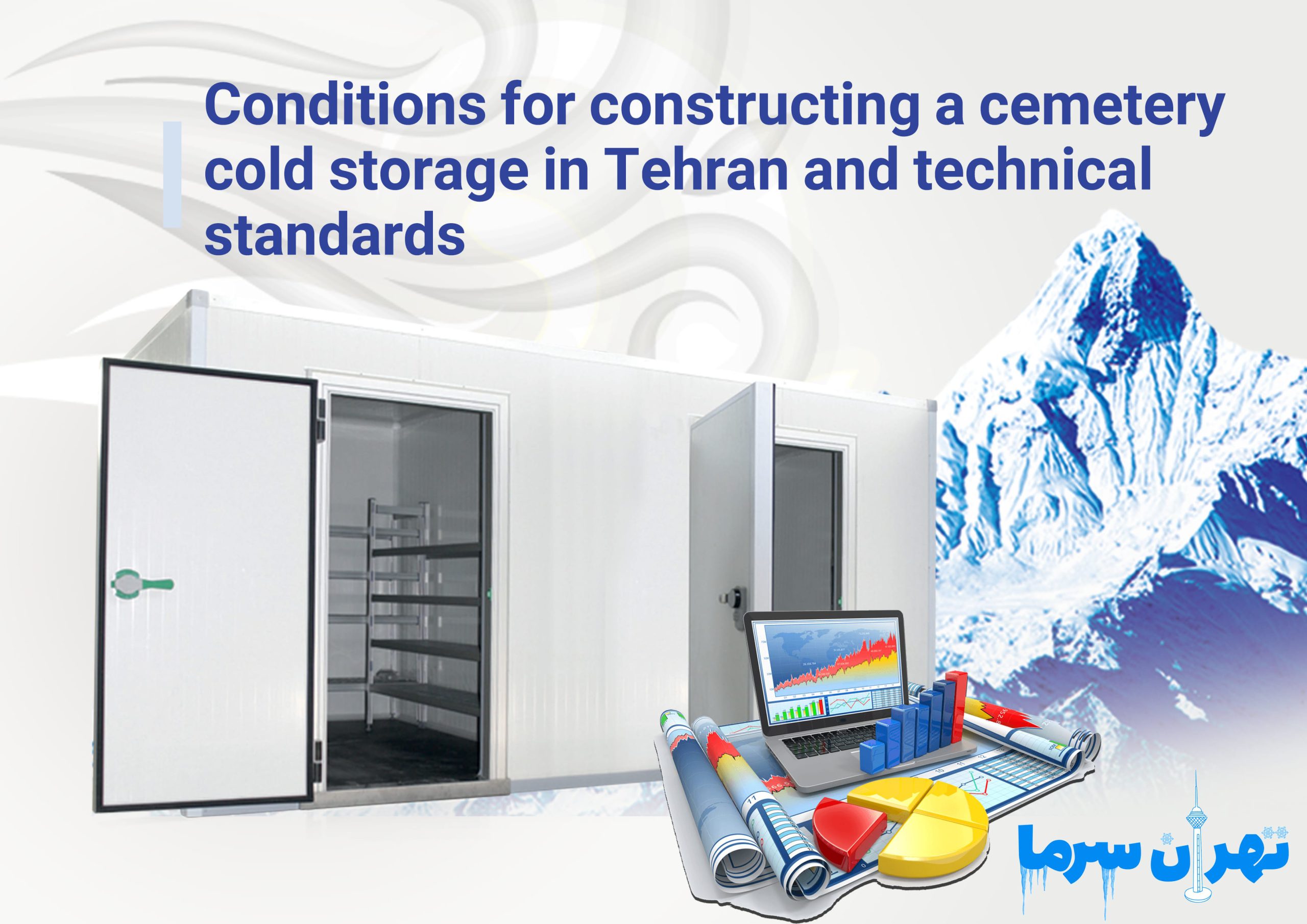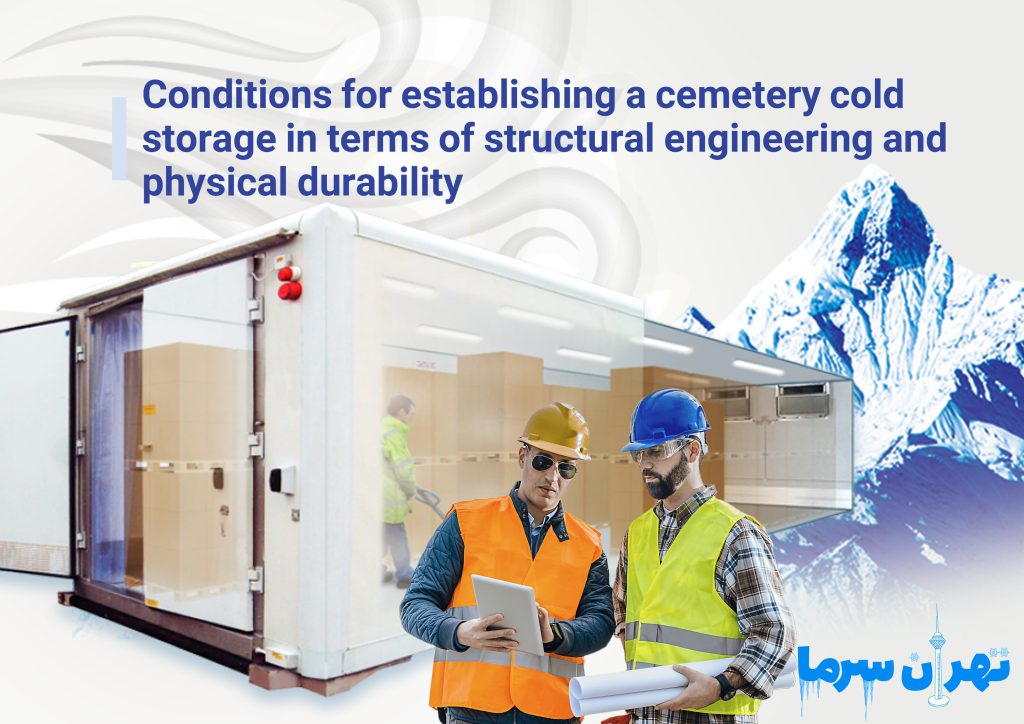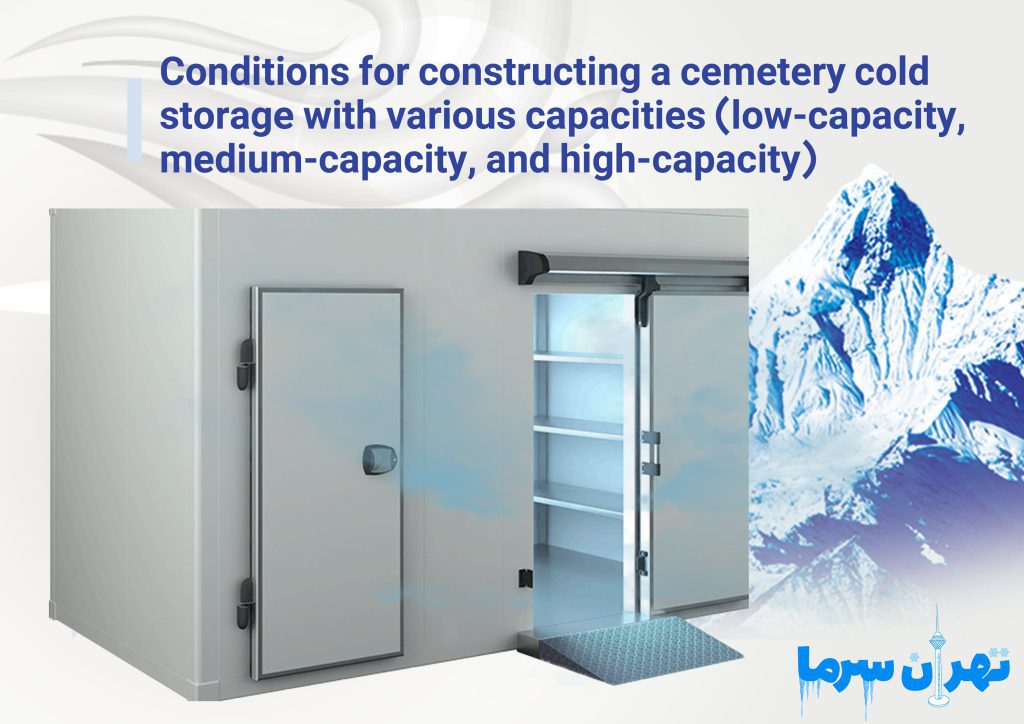Uncategorized
Conditions for Constructing a Cemetery Cold Storage in Tehran and Technical Standards

The construction of a cemetery cold storage requires compliance with specific health, technical, and environmental regulations. Additionally, obtaining the necessary permits from relevant authorities and adhering to safety standards are essential for establishing such facilities. Furthermore, the conditions for constructing a cemetery cold storage in Tehran may include special regulations tailored to the city’s population and urban space constraints.
Conditions for Constructing a Cemetery Cold Storage and Selecting an Appropriate Location
One of the most critical considerations in building morgue cold storages is selecting a suitable location. In Tehran, due to spatial limitations and high population density, the location must be determined based on criteria such as easy accessibility, adequate distance from residential areas, and the feasibility of installing necessary facilities. Additionally, considering Tehran’s climatic conditions, including temperature fluctuations and humidity levels, is crucial for designing cooling and ventilation systems.
Conditions for Establishing a Cemetery Cold Storage and Temperature Standards
From a technical perspective, maintaining proper temperature and humidity levels is of paramount importance. The standard temperature for short-term body storage is typically between 2 to 4 degrees Celsius, while long-term storage requires temperatures below -15 degrees Celsius.
Cooling systems must have high operational stability to prevent temperature fluctuations. The use of proper thermal insulation in the walls, ceiling, and floor of the cold storage is another essential technical requirement.
Conditions for Constructing a Cemetery Cold Storage in Tehran
Another crucial factor in constructing these facilities is the ventilation and air quality control system. Proper airflow design and the use of specialized filters are necessary to prevent the spread of unpleasant odors and pathogens. Additionally, an emergency power system should be in place to ensure continuous operation in case of a power outage.
Besides technical considerations, compliance with health and safety standards is mandatory. The use of rust-resistant and moisture-resistant materials for interior surfaces enhances the durability of equipment and facilitates cleaning and disinfection. Furthermore, installing alarm systems for temperature control and detecting potential failures plays a vital role in preventing sudden issues.
The construction of a cemetery cold storage in Tehran requires adherence to engineering principles, health standards, and environmental regulations. Utilizing advanced equipment, optimizing the design, and meeting essential requirements significantly contribute to the efficiency of these facilities.
Structural Engineering and Physical Resistance Considerations for Establishing a Cemetery Cold Storage
One of the most crucial factors in designing a cemetery cold storage is selecting the appropriate structural type based on the geographical location and geological characteristics of the construction site. In areas like Tehran, where earthquakes are possible, the structure must be designed to withstand seismic vibrations.
To achieve this, the use of a solid foundation and earthquake-resistant structures is highly important. Additionally, soil assessments and geotechnical studies must be conducted before construction begins to prevent uneven settlement or structural cracks.
Another key consideration is selecting durable and resilient construction materials. Reinforced concrete, stainless steel, and thermal and moisture-resistant insulation materials are among the best options for building the walls, ceiling, and floor of the cold storage.
These materials must withstand temperature changes and high humidity while resisting corrosion, decay, and environmental damage. Additionally, the walls should have standard thickness and proper insulation to prevent heat leakage and enhance the efficiency of cooling systems.
Ventilation and humidity control systems also play a crucial role in structural stability and preventing gradual deterioration of the building’s interior components. Cold storage designs must incorporate effective ventilation systems to prevent moisture buildup and the growth of harmful microorganisms such as fungi and bacteria. Furthermore, the floor should have appropriate drainage slopes and outlets to prevent water accumulation and structural decay.
Mechanical load-bearing capacity is another engineering concern in cold storage construction. These facilities must support the weight of heavy equipment, specialized shelving for body storage, and staff movement. To ensure structural integrity, using a robust steel framework or properly designed reinforced concrete structures is recommended.
Additionally, installing pressure- and impact-resistant doors and ensuring the strength of ceilings and walls to prevent sagging or cracking are essential considerations.
Beyond structural resistance, ensuring safety against emergencies is also crucial in cemetery cold storage construction. Equipping the facility with alarm systems to monitor temperature changes, detect hazardous gas leaks, and manage power outages can prevent serious incidents. Moreover, backup power systems and emergency generators should be considered to ensure uninterrupted operation during power failures.
Facility Requirements for Constructing a Cemetery Cold Storage (Emergency Power, Ventilation, and Insulation)
Constructing a cemetery cold storage involves adhering to a set of technical and operational standards to ensure optimal and continuous functionality. Among these, providing essential facilities such as emergency power, proper ventilation, and effective insulation plays a key role in enhancing efficiency and safety.
The design and implementation of these components must maintain optimal conditions for body storage while preventing potential issues such as temperature fluctuations, excessive energy consumption, and equipment failures.
One of the most critical facility requirements for constructing a cemetery cold storage is ensuring emergency power supply. Given the importance of maintaining stable temperatures and continuous cooling system operation, a backup power source is essential to prevent disruptions during sudden power outages.
For this purpose, diesel generators or automatic emergency power systems are commonly used. These systems must be selected based on the power consumption of the cooling equipment and should provide sufficient energy for extended periods. Additionally, the electrical distribution system must be designed to withstand voltage fluctuations and short circuits to prevent equipment damage.
In addition to emergency power, an efficient ventilation system is another fundamental requirement in cemetery cold storage construction. Proper air circulation prevents moisture accumulation, unpleasant odors, and the growth of harmful microorganisms.
Ventilation must be designed to allow continuous fresh air intake and effective removal of contaminated air. To achieve this, exhaust and intake fans with adjustable speeds and airflow capacities are used. Furthermore, specialized filters in the ventilation system’s intake and exhaust points can improve air quality and reduce environmental contamination.
Insulation is also a crucial factor in cemetery cold storage construction, directly affecting temperature maintenance and energy efficiency. The walls, ceiling, and floor must be fully insulated to prevent heat transfer and energy loss.
For this purpose, polyurethane foam, insulated sandwich panels, and moisture-resistant materials are commonly used. These materials not only prevent energy wastage but also enhance the longevity of cooling equipment. The thickness and type of insulation should be selected based on regional climatic conditions and the storage facility’s capacity to ensure optimal performance.
The integration of these three key elements—emergency power, ventilation, and insulation—has a significant impact on the overall efficiency of cold storage facilities. A well-designed facility system should not only meet essential requirements but also prevent potential problems over time.
Compliance with safety standards, using high-quality equipment, and properly implementing facility systems are crucial aspects of cemetery cold storage construction. Overall, the process requires careful planning and technical precision to create a standardized and efficient environment for body storage.
Construction Conditions for Cemetery Cold Storage in Cold, Hot, and Humid Climates
The construction of cemetery cold storage in different climates must be adapted to local weather conditions to ensure optimal performance and structural durability. In cold regions, proper insulation and supplementary heating systems are essential to prevent freezing of equipment and interior walls.
In hot climates, high-capacity cooling systems and heat-resistant insulation materials must be utilized to reduce energy consumption and prevent temperature fluctuations. In humid regions, designing a strong ventilation system and using corrosion-resistant and anti-fungal materials are critical to preventing excess moisture buildup and structural damage. Adhering to these considerations, along with selecting climate-appropriate materials and equipment, plays a key role in increasing the longevity and efficiency of cemetery cold storage facilities.
Construction Conditions for Cemetery Cold Storage with Various Capacities (Small, Medium, and Large Capacity)
The construction of cemetery cold storage with different capacities should be based on population needs, available space, and technical requirements. Small-capacity cold storages focus on space efficiency, smaller cooling systems, and lower energy consumption, while medium-capacity facilities must balance size, cooling capacity, and operational efficiency.
For large-capacity cold storages, strong emergency power supply, effective ventilation, high-power cooling systems, and a sectioned layout for better space management are essential. In all capacity types, compliance with health standards, effective insulation, and designated pathways for body transportation are critical factors that directly impact efficiency and functionality.
Best Construction Conditions for Cemetery Cold Storage with Tehran Sarma Engineering Company
The best cemetery cold storage construction conditions, in collaboration with Tehran Sarma Engineering Company, are based on compliance with technical, health, and environmental standards to ensure a high-quality and durable facility. This company utilizes advanced cooling technology, optimized insulation design, and efficient ventilation systems to provide ideal conditions for body storage.
For more details, visit Tehran Sarma’s website or contact them at +98 9121906418 or +98 2177972256.




 سردخانه
سردخانه برق
برق کمپرسور
کمپرسور کمپرسور بیتزر
کمپرسور بیتزر کمپرسور کوپلند
کمپرسور کوپلند کمپرسور بوک
کمپرسور بوک کمپرسور دانفوس
کمپرسور دانفوس کمپرسور منیروپ دانفوس
کمپرسور منیروپ دانفوس کمپرسور امبراکو
کمپرسور امبراکو کمپرسور پاناسونیک
کمپرسور پاناسونیک کمپرسور سابکول
کمپرسور سابکول کمپرسور کوپلند
کمپرسور کوپلند کمپرسور اسکرال کوپلند
کمپرسور اسکرال کوپلند کمپرسورفراسکلد
کمپرسورفراسکلد کمپرسور رفکامپ
کمپرسور رفکامپ کمپرسور اسکرال دانفوس
کمپرسور اسکرال دانفوس گاز مبرد
گاز مبرد گاز R22
گاز R22 گاز R134
گاز R134 گاز R404
گاز R404 گاز R407
گاز R407 گاز R410
گاز R410 گاز R508
گاز R508 کندانسور هوایی
کندانسور هوایی اواپراتور
اواپراتور اواپراتور آرشه
اواپراتور آرشه اواپراتور صابکول
اواپراتور صابکول اواپراتور آسه
اواپراتور آسه اواپراتور نیک
اواپراتور نیک اواپراتور آرتک
اواپراتور آرتک اواپراتور نوین
اواپراتور نوین اواپراتور تبادل کار
اواپراتور تبادل کار درب
درب ساندویچ پنل
ساندویچ پنل فن سردخانه
فن سردخانه روغن کمپرسور سانیسو
روغن کمپرسور سانیسو متعلقات سردخانه
متعلقات سردخانه